
- Home
- India
- World
- Premium
- THE FEDERAL SPECIAL
- Analysis
- States
- Perspective
- Videos
- Sports
- Education
- Entertainment
- Elections
- Features
- Health
- Business
- Series
- In memoriam: Sheikh Mujibur Rahman
- Bishnoi's Men
- NEET TANGLE
- Economy Series
- Earth Day
- Kashmir’s Frozen Turbulence
- India@75
- The legend of Ramjanmabhoomi
- Liberalisation@30
- How to tame a dragon
- Celebrating biodiversity
- Farm Matters
- 50 days of solitude
- Bringing Migrants Home
- Budget 2020
- Jharkhand Votes
- The Federal Investigates
- The Federal Impact
- Vanishing Sand
- Gandhi @ 150
- Andhra Today
- Field report
- Operation Gulmarg
- Pandemic @1 Mn in India
- The Federal Year-End
- The Zero Year
- Science
- Brand studio
- Newsletter
- Elections 2024
- Events
- Home
- IndiaIndia
- World
- Analysis
- StatesStates
- PerspectivePerspective
- VideosVideos
- Sports
- Education
- Entertainment
- ElectionsElections
- Features
- Health
- BusinessBusiness
- Premium
- Loading...
Premium - Events
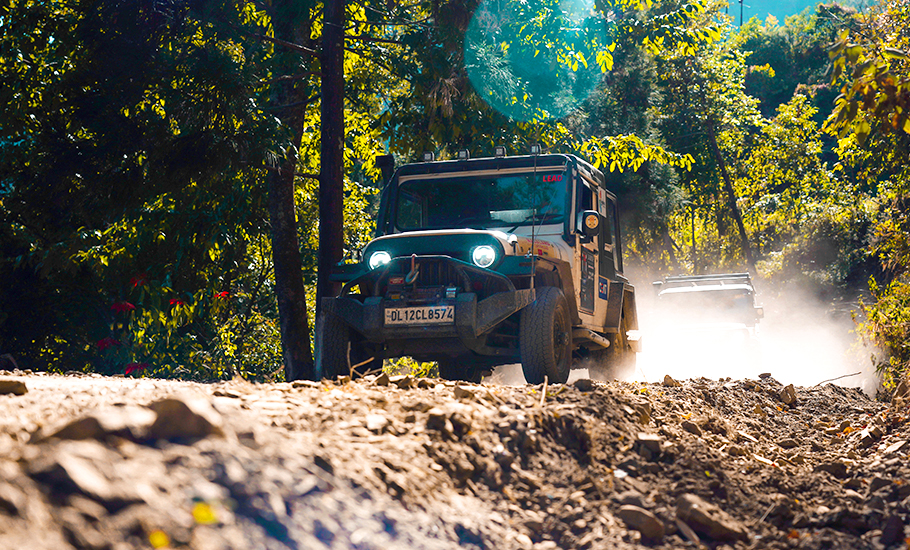
What an 8-day off-roading journey through the heart of Nagaland taught me

It was 5 am. Dressed in five layers of clothing, including a woollen jacket, I had just managed an hour or two of sleep. It had been extremely cold, and getting out of my sleeping bag seemed almost impossible. When I unzipped my tent, I witnessed the most spectacular sunrise I had ever seen. The sky was folded in layers of blue, amber, gold and pink. I took a deep breath and for a few moments,...
It was 5 am. Dressed in five layers of clothing, including a woollen jacket, I had just managed an hour or two of sleep. It had been extremely cold, and getting out of my sleeping bag seemed almost impossible. When I unzipped my tent, I witnessed the most spectacular sunrise I had ever seen. The sky was folded in layers of blue, amber, gold and pink. I took a deep breath and for a few moments, I just sat at the edge of the tent and soaked it all in.
We were at Kapamodzu peak, and were the first crew ever to camp there. It had taken us an arduously long drive to get there, but at that moment, while sitting outside my tent and looking up at the sun, none of that seemed to matter. “Have you seen anything so magical before?” Nidhi Salgame, the founder of extreme overlanding venture, Wander Beyond Boundaries, and the one leading our off-roading journey, in the remote parts of Nagaland, asked me. I only managed to nod in silence.
A few weeks ago, I remember receiving a call from Nidhi, explaining what to expect on our 8-day long journey. “This won’t be a luxury holiday. It is for the discerning traveller who seeks new experiences,” she warned. At the other end of the telephone, I wondered what was in store.
Exiting the comfort zone
My flight from Mumbai had a stop at Delhi and would then land in Dimapur. In the check-in queue at the Delhi airport, a bunch of tourists heading to Dimapur all talked about their itinerary for the ongoing annual Hornbill festival. The few tourists who venture to the state often find themselves visiting Dimapur because of flight connectivity, Kohima and Kisami a few kilometres away from Kohima, where the Hornbill Festival is held. Very few travellers visit the interiors of Nagaland.
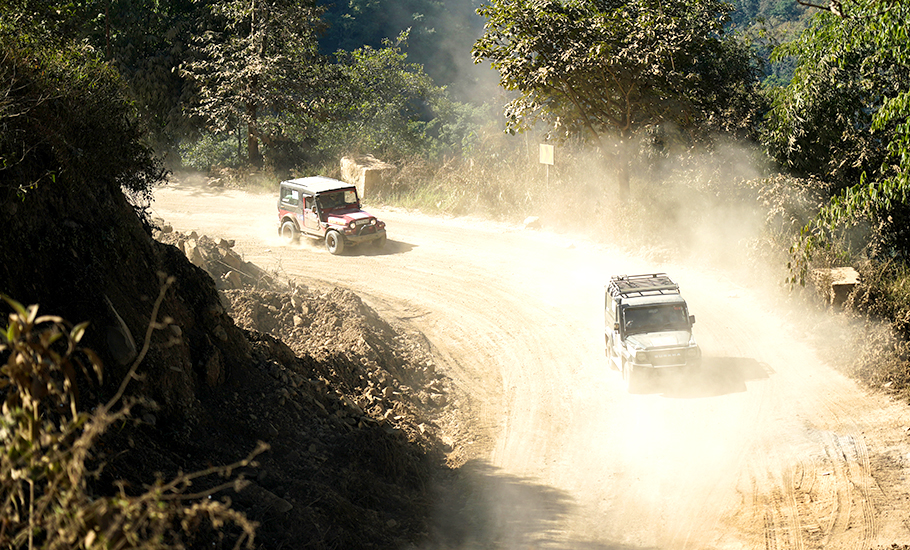
“What do you know about Nagaland apart from the Hornbill Festival?” Nidhi asked the bunch of us traveling together. I knew — what I had read — that there are 17 documented tribes in the state, they wore colourful costumes, unusual head gear and beautiful jewellery; and what I had heard – the tribes have strange rituals, they were headhunters in the past, they were always at war with each other, had a bloody past, a history of insurgency, their ways were believed to be “savage” and they ate whatever they could get their hands on, including dog meat. Also that the locals didn’t like visitors from the ‘mainland’. I had no idea at the time, that everything I thought I knew about Nagaland was about to change in the course of the next few days.
Nagaland is a nature lover’s paradise. The mostly mountainous state is full of lush forests, mist-clad hills and an incredible variety in flora and fauna. You can place your camera almost anywhere and it will make for a perfect frame. The idea behind this off-roading expedition was that while the interiors promise spectacular landscapes and offer a glimpse into ancient Naga culture and indigenous tribal communities, very often, a 4×4 is the only way to reach them. Nidhi and her team at WBB have mapped routes that didn’t exist and sorted them in categories from easy and moderate to difficult and extreme. They spent long hours driving to remote locations and finally launched their website and app in December 2022.
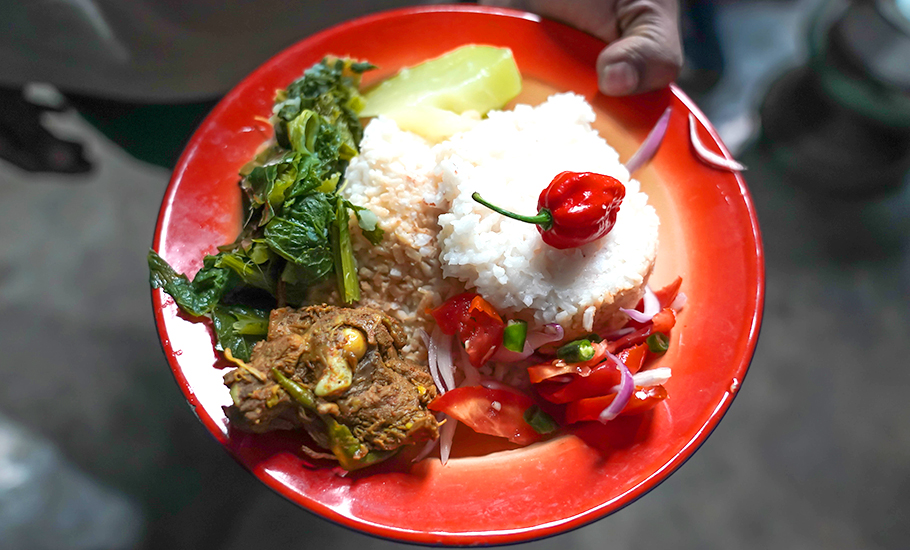
Today, the Nagaland Offroad website and app helps travellers navigate through this terrain and furnishes them with essential information. What helped WBB the most in this endeavour though, is the warm hospitality of the locals who came forward and offered support. This is the hospitality I experienced in the week we spent in the villages in Nagaland too.
Pride and prejudice
Nestled on top of a hill, Zapami, in the Phek district, was the first village we stopped at. We spotted the identical green roofs of the houses from a distance. We met young members of the village council and the students’ union who had taken it upon themselves to show us around their village that day. It was hard to miss the pride in their eyes when they took us to a museum that showcased the history and the way of life of the Chakhesang tribe. I didn’t feel the sense of ‘them and us’ or any sort of resentment towards travellers.
They were happy to have people visit the village and show an interest in their culture. While most of Zapami follows agriculture as their primary occupation, this village is home to talented weavers who use stinging nettle to painstakingly create artistic shawls and waistcoats. While the tradition had ceased to exist for about 30 years, it is only recently with the assistance of a local NGO, that the craft has been revived. Despite the profit margins not being high, the women in the village take pride in keeping the art alive by teaching the younger generation.
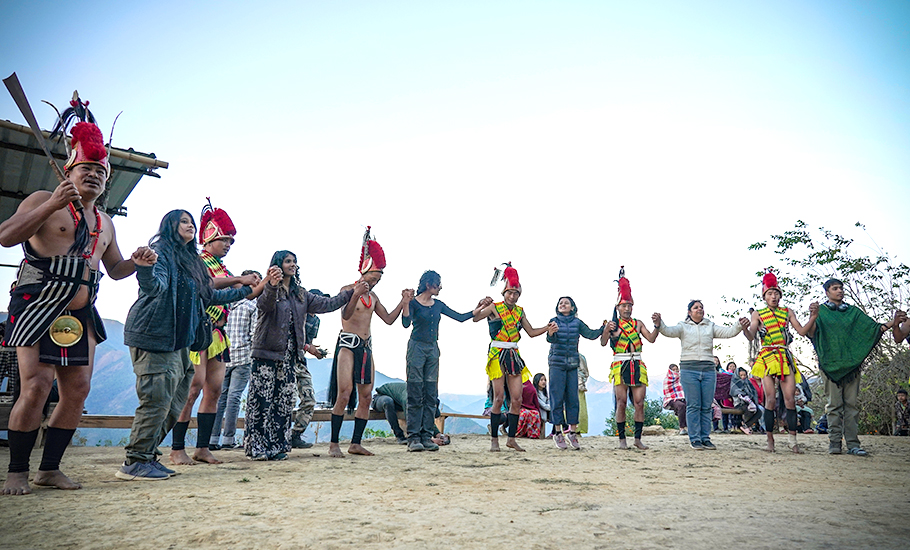
One of the young members of the village council Ari, hosted us for lunch, in her home. In Nagaland the predominant meat is pork, followed by chicken and fish. The meals were simple and full of flavour. Techniques such as smoking, drying and fermenting are often used to cook the meat. Rice is the staple grain and most meat preparations were accompanied by edible leaves or saag. Mustard leaves for example were part of many of our meals. The fish is usually served cold in Naga cuisine. The famed Naga chilly can add a fiery twist to certain dishes and the occasional local rice beer was our poison of choice. We were surprised to learn that Nagaland has over 200 different varieties of rajma (kidney beans).
Each house in the village has a granary that stores grains like rice in large cane baskets. The size of the granary usually determines how wealthy a family is. We noticed that a unique symbol of crossed horns adorned the roofs of some of the houses. On enquiring, we were told that this was a symbol of status and is earned by families who host a feast for this village and also the two adjacent Chakesang villages.
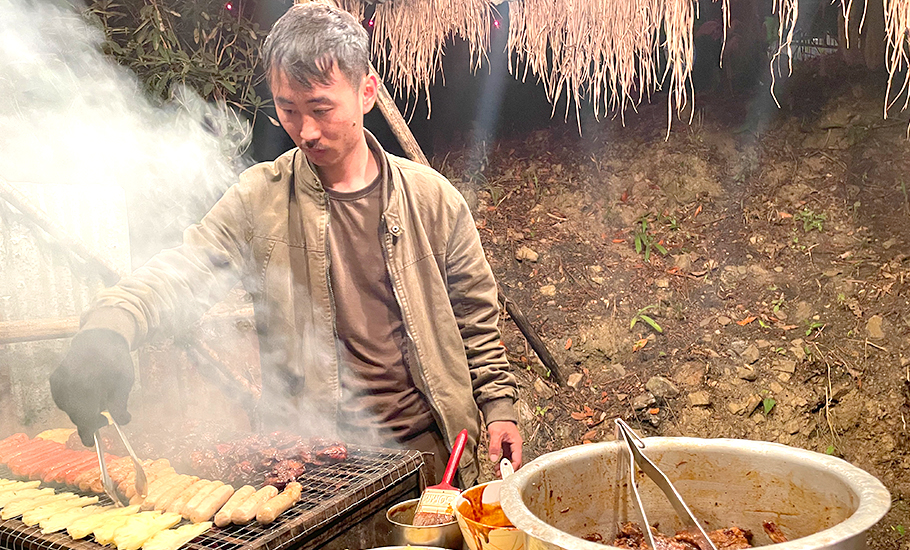
Just like Zapami, in each village we visited, the villagers opened their homes to us. Some of them even let us pitch our tents in their backyards. Hot home-cooked meals and comforting bonfires waited for us at the end of each long drive. The villages we visited were spotlessly clean. Most homes were organised in an impeccable manner.
Of love and respect
While many of the young people in the villages spoke English, the elders who couldn’t converse because of a language barrier tried to communicate with their actions and smiling eyes. Every village has a headman or a Gaon Bura who is responsible for the development and well-being of the village. He is in-charge of almost all matters regarding the village including solving everyday issues and even taking a decision regarding offences and crimes and meting out punishment for the same. In Nagaland, the customs of the tribe are kept in mind while deciding on an appropriate punishment and they do not follow the rules of the Indian Penal Code.
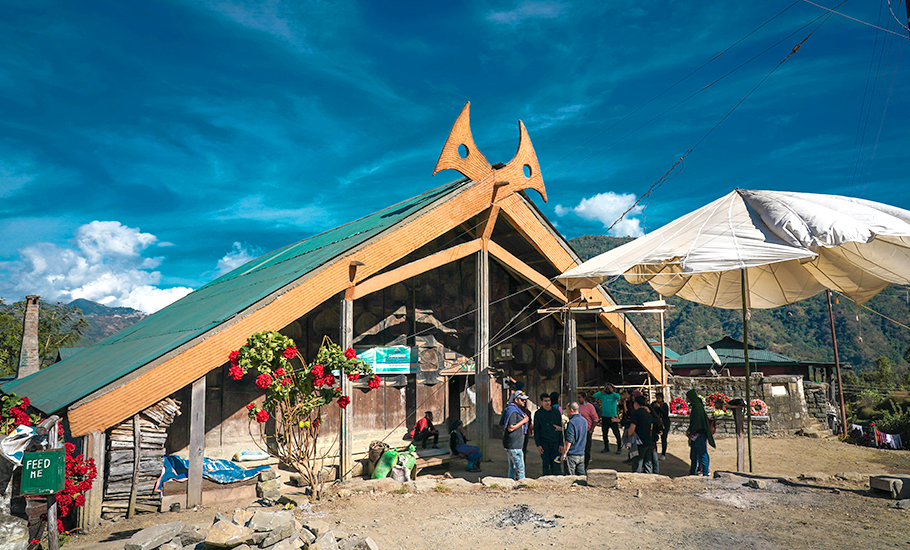
We had the opportunity to meet Ashelo Theviiry, the enthusiastic Gaon Bura of Phokhungri village. A young-at-heart and jovial person, Ashelo hopes to present the culture and traditions of his tribe to the world. A scenic drive took us to Pokhungri village where male members of the Pochury tribe were dressed in vibrant red, yellow and green traditional costumes with elaborate headgear and eye-catching accessories, including a necklace of monkey skulls around their necks. They were going to perform the Oh-hia dance. The women and children assembled around to watch the performances and giggled at regular intervals. Some of them even took photos and videos on their phone. One of the younger members of the tribe had his own YouTube channel and wanted to post a video of the performance and requested us to be a part of it. We happily obliged.
On our way to the village, we spotted two young boys carrying rifles. When we enquired what they were for, we found that it was common for men to have a hunting gun.
Interestingly, during the Indian freedom struggle, the British had a tough time with the Nagas, and Nagaland remained undefeated because they already had their own guns. “We use the guns to hunt. It is never misused,” Ashelo assured us.
It is important to mention that at no point in the week that we travelled in Nagaland did we feel unsafe or threatened. On the contrary, we encountered kindness and hospitality at its best.
Weaving stories
While Zapami weaves the stinging nettle, weaving is a common skill among most tribes in Nagaland and is usually passed on from one generation to the next. Many of them however only weave enough to sustain themselves. Each home in these villages has a loom. In the Chizame village we visited, a livelihood project was started in 2018 to offer opportunities to women in rural Nagaland to earn a living.
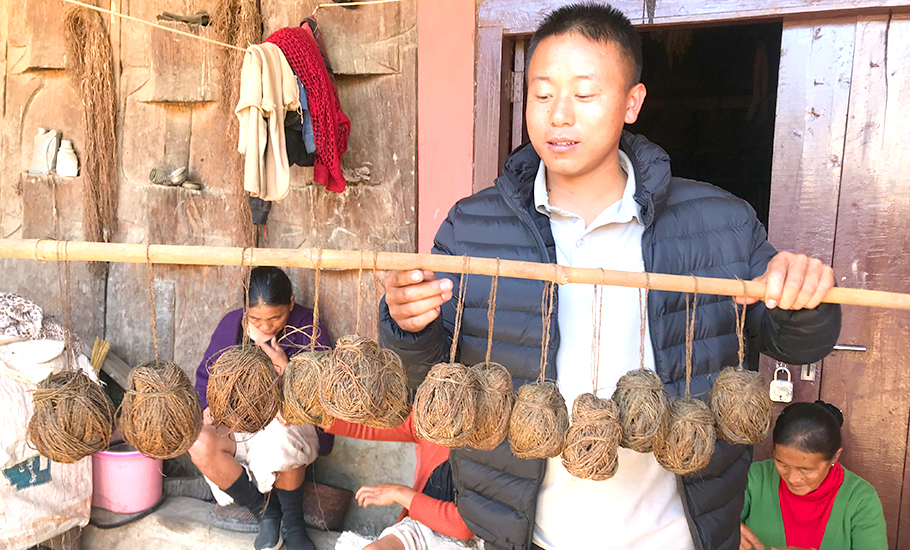
Master weavers trained local women from the Chakesang tribe in making commercially viable handloom products. More than 600 women are now part of Chizami Weaves. When we browsed through the collection at their store in the village, we found both the traditional and contemporary designs appealing. The colours ranged from soft and muted to bright and vibrant and we could choose from a wide range of products such as cushion covers, shawls, skirts, coasters, table mats and bags.
Convoy code
We drove in a convoy. The rules were strict and to be followed at all times. The ‘Lead’ (the first car in the convoy) was not to be overtaken and the “Sweep’ (the last car in the convoy) was to keep track of the cars in front. Driving in a convoy brought a certain discipline in the group. It also helped us keep pace so that we made it to our destinations in time. Walkie talkies helped us communicate with the other vehicles.
Borders, boundaries and balance
We crossed Tsupfume, the historic WW-II battleground, where the action against Japanese forces took place on Indian soil in 1944, and then went on to Avakhungvillage on the Indo-Myanmar border. The roads to many of these villages are rough. “Some of the mud tracks test both man and machine. It will test your physical and mental strength,” Nidhi told us just before we undertook a long ride to Shilloi Lake, the largest natural lake in Nagaland which lies on the Indo-Myanmar border, and another long ride back to Dimapur a few days later.
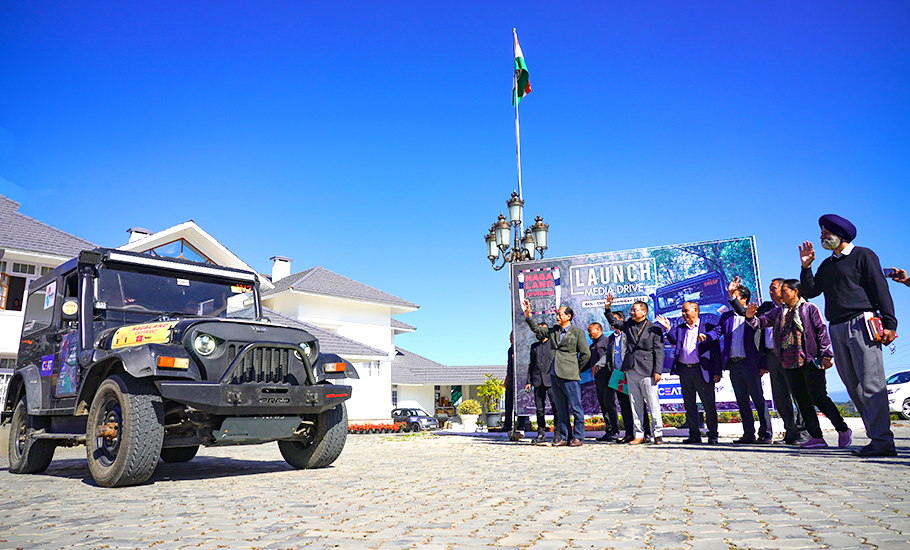
Apart from the terrain being tough to navigate, finding transport such as taxis is both expensive and difficult in remote areas. The 4X4 was the best way for us to get around and it did all the heavy lifting on most days. We spent long hours on the road and the vehicle was as good as a home for us on this unique journey. We carried food, refreshments and camping equipment, all in these off-roading vehicles sponsored by Nagaland Tourism and Wander Beyond Boundaries. On most long rides we would stop for tea and coffee breaks and have what we called the ‘bonnet cafe’. On one occasion we also made Maggi noodles on portable stoves.
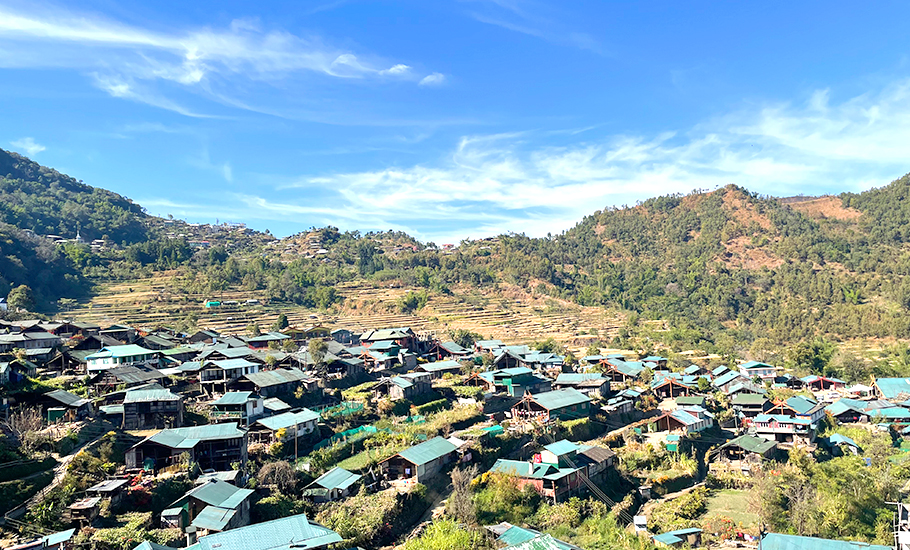
At each place, we made sure that we didn’t litter and created as less waste as we could. When our tents were rolled back into our cars, each place looked as it was when we first got there. The beauty of Nagaland made me hope that many more travellers will find it in themselves to go that extra mile to experience the state, that there are more accommodation options so that people of all age groups can come to Nagaland. However, at the end of our week here, I wished even harder that when these travellers do come, the bounty that nature has blessed Nagaland with remains intact and the warmth and respect that the people of Nagaland gave us is reciprocated by thoughtful travellers who respect the homes, culture, traditions and surroundings of the Naga people.
